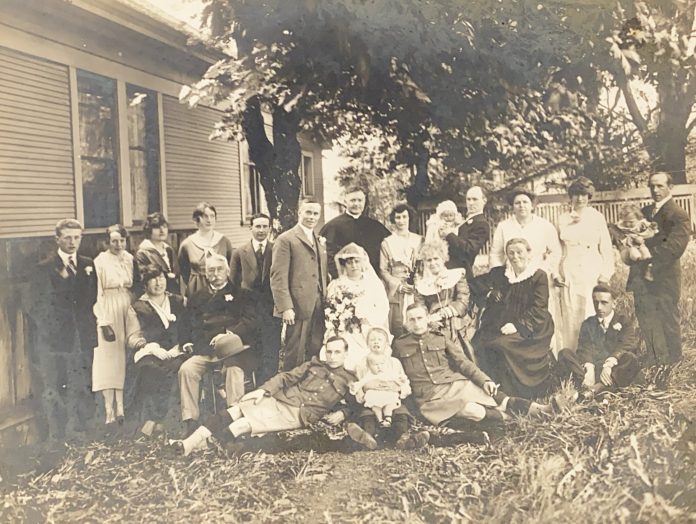
What did an impoverished British mother and father do when they had sixteen children at the turn of the last century? They sent some of them to children’s homes, only to have their little ones – often without their parents’ knowledge – shipped to Canada from there. How did they choose which ones to send away?
According to Roy Parker, author of Uprooted; The Shipment of Poor Children to Canada, 1867-1917, the decisions of parents about which of their children to part with was largely economic. The earnings of older children were crucial to the survival of poor British. “No wonder the parents wanted to have their children back when they reached a certain age to earn and when they no longer constituted a burden on fragile family resources,” Parker writes. Unfortunately, few children were returned to their parents once they were turned over to a “rescue” society. They were gone to Canada, many never to return to their families and homeland.
This happened to May Ratcliffe (1895-1966) and four of her siblings. Their parents, John (1849-1927) and Blanche Marguerite [La Croix] Ratcliffe (1852-1934) selected from among the youngest of their 16 offspring to send away. The children were separated from their parents, brothers and sisters and sent separately to different places in Canada. Some were reunited later, some were not.
Child number 10 Albert Ratcliffe (1885-1962) was the first to go. At age 12, he boarded the ship, State of California, at Liverpool on 22 July 1897, and landed in Quebec on 31 July 1897. His sponsoring agency was the Southwark Catholic Emigration Society. He was sent to St. Vincent’s Receiving Home in Montreal. By 1901, at age 16, he was working as a domestic on the farm of Patrick Bradley and family in Wakefield Township, Quebec.
Brothers Charles (1888- ) and Edouard (Edward, 1889-1968), the Ratcliffe’s children #12 and #13 respectively, set sail from Liverpool on 5 May 1899 aboard the Gallia. Sponsored by the Catholic Emigration Committee, they arrived at a distribution home in Ottawa shortly after their arrival on 13 May 1899. From there, they were sent out to homes or farms that had applied for a British Home Child. According to the 1901 Canada census, Edward was working as a domestic servant for a widowed dressmaker at Nepean, Ontario.
Marie (1887-1993) was the next to go. Ratcliffe child #11, she emigrated at age 15 from Liverpool to Quebec aboard the Tunisian, 16 Oct to 25 Oct 1902. Marie was sent to a Catholic Emigration Society distribution home in Ottawa and went to work as a domestic at a family’s home. Marie moved back to England in about 1911 and lived to the age of 106.
Now we come to May (1895-1966), the second-last (15th) child born to John and Blanche Ratcliffe. May was sent to live in St. Patrick’s Catholic Orphanage in Prince Albert at age 8 aboard the ship Tunisian. She left England on 7 May 1903 and arrived in Quebec on 15 May. The Canadian censuses for 1906 and 1911 show May living at the Prince Albert orphanage.
May “aged out” of the orphanage at age 18 and moved to Victoria where she reunited her mother Blanche and her three sisters, Blanche (the eldest of the Ratcliffe children, 1872-1951), Elise (1893-1979), and Mabel (the youngest, 1896-1993).
I’m not certain what happened between the parents, John and Blanche Ratcliffe. The 1911 census shows them living together in Brighton, England with four of their daughters. Did John abandon them? Did Blanche leave him? In 1912, Blanche (recorded on the ship’s passenger list as 60 and married) sailed aboard the “Ascania” with those same four daughters from Southampton to Quebec enroute to visit May in Victoria, BC. They never left. The 1921 Canada census records Blanche as a widow at age 69, living with her 3-year-old granddaughter Victoria de Macedo (May’s daughter) in Victoria where she ran a boarding house.
May worked as a civil servant in Victoria for the Province of British Columbia, likely in the Lands Department where Kiem de Macedo also worked. This is probably how she met her future husband, Louis de Macedo, Kiem’s brother. On 10 August 1914, May Ratcliffe exchanged vows with Louis de Macedo (1881-1960); she was given away by her mother Blanche.
Three of May’s sisters also married into the de Macedo family. The eldest, Blanche, who was 30 years old when she arrived in Canada, married Kiem; Elise married Frank; and Mabel, the youngest, married Fred Banks, the de Macedo’s former butler who came to Canada with the family.
May must have also reunited with at least three of her four British Home Child siblings. Albert, Charles and Edward all ended up in British Columbia. Albert, a farmer and logger, died at Cowichan Bay on Vancouver Island in 1962. Charles, a railway brakeman, enlisted in the Canadian army in Vancouver in 1918 at age 30, but never went overseas. Edward, who was an engineer for the Canadian Pacific Railway, died in White Rock, BC in June 1968.
May and Louis had four daughters and one son, Maurice, who was killed in action during the Second World War. Louis passed away in January 1960, and May died on 22 July 1966 in Victoria. She is buried at Ross Bay Cemetery in that city.

